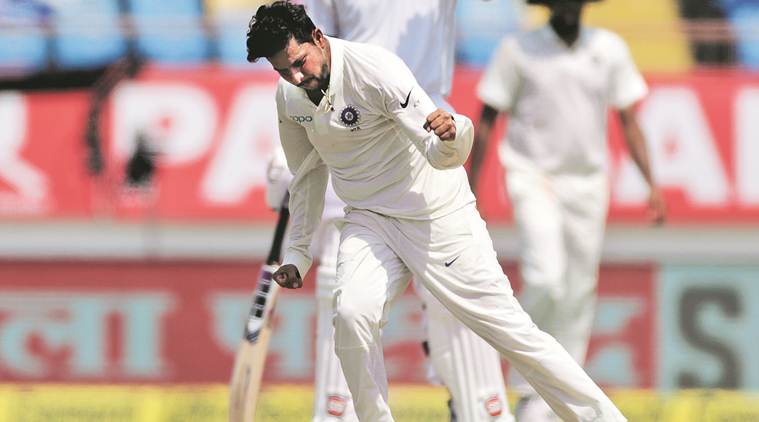
Kuldeep Yadav arrived in India after being dropped for the last two Tests of the England series, his fingers longed for an SG ball. Soon after he reached home, he found a couple of them lying under a table and began flipping them around the room. “The very feel of an SG ball brought my confidence back,” he says.
The morale was in tatters after the Lord’s Test, where he admits he found the harder Duke ball, with its pronounced seam, difficult to grip. You could find his struggles in the highlights reel of the Test—he evidently struggled with the release, the ball came out hurriedly from his palms, almost slipping out, at a flatter trajectory, robbing him of the two vital ingredients of his bowling—flight and dip. Consequently, his action too was not coming through smoothly. “I was finding it very difficult to grip the ball, as the Duke ball was harder than the SG ball. I was trying to hit good length, but you need at least 15 days to adjust to the Duke balls,” he says.
He went wicket-less for nine overs, conceding 44 runs, but on the most spinner-unfriendly surface of the tour. What was thus a perceivably surprise ploy not only back-fired gloriously but was subject to much censuring back home. The immediacy of the four-day matches against Australia probably didn’t let his mind brood over the nightmarish Lord’s Test. “I just had a few days to prepare for the matches and I felt I had to make a few minor changes. So I quickly switched my focus to Australia (A),” he reflected.
Immediately he dialled his mentor from childhood, Kapil Pandey, who asked to come over. “We went to drawing board and worked on a few things regarding my release. Four-five days we bowled almost continuously and kept bowling around the wicket as well as over the wicket,” he says. Consequently, his release point is lower than what it was against England, for the more uncomfortable a wrist-spinner is with the ball, the higher his release point tends to get, so as to get more control. It makes the trajectory flatter and the revs fewer.
The coach realised that he was getting a little too front-on as well, but it was nothing major, and he told him just to keep bowling more with the SG ball. “It was about getting back to what he has been doing, practise it again and rectify those minor glitches,” says Pandey. Both of them spent almost the entire four days bowling, like it was in his teens. A thousand balls a day, says the coach.
The A games could not have come faster—for he could try out everything he has learnt in real match situation and see how he was progressing. “It took me exactly two games to get the rhythm back,” he says, with an impish smile.
In two matches, he nailed 12 wickets at a shade over 20 runs apiece. It wasn’t an entirely inexperienced Australian side either, what with Test players Mitch Marsh, Usman Khawaja, Peter Handscomb and Matt Renshwaw in the line-up. “The confidence was back and I was doing the rights things the coach had discussed with me,” he says. A profitable Asia Cup further shored up his confidence, but he was not satisfied until his resurrected his Test career. “Red-ball cricket is very important to me, and I was keen to make this opportunity count,” he says, beaming.
Admittedly, he didn’t start well against the West Indies, he was a bit one-dimensional with his lengths, bowled one short ball too many. He would just look to flight the ball and beat them in the air, probably encouraged by their enterprising endeavours. He did out-think Shane Dowrich with a vicious delivery that spun back, but thereafter he lost the drift of the game, and ended up being caned for 62 runs in 10 overs, though without bowling too badly.
In the innings break, he reassessed his bowling and figured out where he was erring. “In the first innings I did not anticipate that they (West Indies batsmen) will attack me so much. They have a lot of power hitters and if you give them too much flight, you could end up leaking runs,” he observes.
So in the second, he stopped floating every delivery upto the batsman, trying to deceive him in his flight. Rather he looked to be more accurate, mixed up his lengths and angles, and experiment less. So the Yadav the West Indies batsmen were negotiating in his second innings wasn’t the Yadav they saw in the first. Here was he at his ingenious best, best exemplified by the wickets of Kieran Powell and Shai Hope.
Nearing his hundred, Powell was looking to play more circumspectly. But he was in no mood to punish even marginally short or short of length balls. He hung back and slashed him behind point. Next up, Powell anticipated a slower, tossed-up delivery, but Yadav rifled one in, which broke off the surface and took his edge. Likewise, Hope was made to feel cosy with a few good length balls before the quicker ball pinged him in front. The googly—which the coach says is a definite sight of Yadav in full flow—flummoxed the impetuous Shimron Hetmyer.





